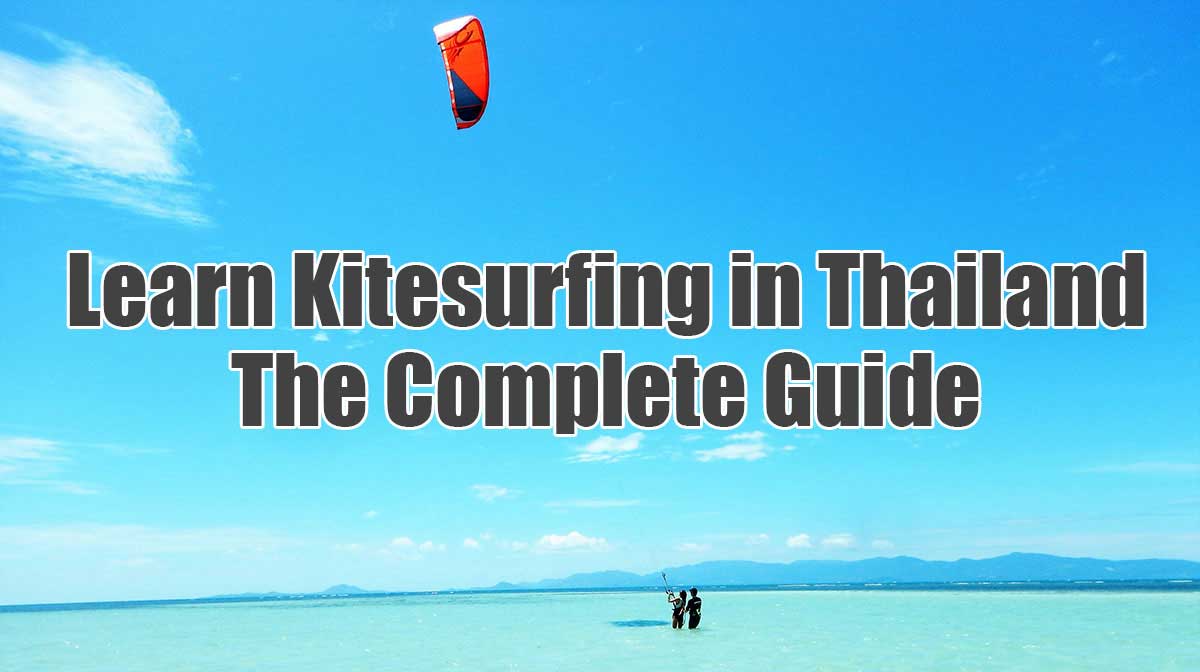Table of Contents
Table of Contents
Learn Kitesurfing in Thailand: The Complete Guide
INTRODUCTION
In this complete guide to kitesurfing in Thailand we go over all the reasons why kitesurfing is an amazing sport and why Thailand has such great spots to kitesurf and especially to learn kitesurfing. This guide is useful for complete beginners as well as experienced riders. We also give you a detailed overview from all the best kitesurf spots in Thailand and when the best time is for kiteboarding at each spot. We’ll explain you what to look out for when you want to choose a good kitesurf school. And finally we give you some basic knowledge about kitesurfing and explain you the theory about the wind, spot, equipment. etc..
SECTION 1: KITESURFING IS AWESOME
Why everyone should try kitesurfing
Easy to learn
Kitesurfing has become immensely popular over the last years and there are many good reasons for that. If you’re reading this you may remember the first time you saw someone kitesurfing and got that ‘waaaaw i want to do this’ feeling. Contrary to what many people think, kitesurfing is quite easy to learn, regardless of your gender, age or previous experience in similar sports. Kitesurfing is more about technique than physical strength, and with the right instruction anyone can learn.
The Rush
One of the main reasons people all over the world get addicted to kitesurfing is the feeling it gives to the person when they use the power of the wind to glide over the water. It’s a mix of euphoria and adrenaline which makes you feel amazing and gets you hooked on the sport. For many people it also works as a form of healing and meditation. Once you are out there riding, your mind let’s go of all the worries and stress and you get into the zone. This is where you will feel zen en focused. The natural aspect of the sport plays a big part because the water and wind brings us more in touch with nature.
Besides the mental benefit, kitesurfing is great exercise has an overall positive impact on our body. While kitesurfing you will use your whole body and most muscles, and it is fantastic for building core-strength. It’s the most fun abs-exercise on the planet and who doesn’t want to get a six-pack while having a great time!!

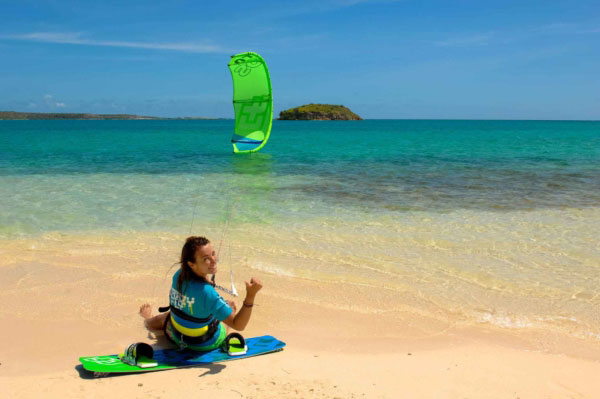
Safety
In general kitesurfing is a very safe sport to practice. For non-kiters this sport might still appear dangerous, and some people might fear getting injured, but with the proper instruction the risk of injuries is low. Crashing on the water is generally a lot more forgiving than crashing on land or snow, and the latest kites have numerous safety systems which can be activated in case of an emergency to make sure the rider stays unharmed.
It is highly recommended that you do not start kitesurfing without taking lessons from a professional school. It is very important to know how to control the kite in a safe manner and learn how all the safety systems work.
Travel
The travelling aspect is one of the main reasons why so many people are attracted to this sport/discipline. You can kitesurf all over the world, with numerous amazing and far-flung kite-spots to discover. Nowadays kite equipment is compact and light, which makes it easy to bring it on an airplane without extra costs. A few of the top destinations for kitesurfing are Thailand (obviously), Spain, Srilanka, Dominican Republic, Brazil, Morocco, etc..
” Kitesurfing is an amazing sport. It keeps me fit and brings me in contact with incredible people and places all over the world , Sir Richard Branson”
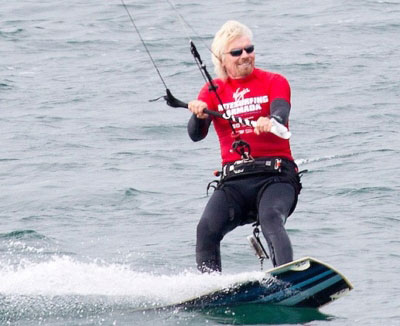
We are all friends
Kitesurfing is a very social sport. When you’re out riding, you’re on your own, but there is a huge social aspect to it nonetheless. Kitesurfers quite often need some assistance, for example when launching and landing the kite. In general kitesurfers are very helpful, and will assist beginners if needed. The community is close knit, and often after riding they’ll hang out and share experiences/stories. It is and remains a great way to meet new people from all over the world and make new friends in the process.
Why learn to kitesurf in Thailand?
So, if you’ve caught the kitesurfing bug, there are many reasons that make Thailand the ideal location for a beginner to learn the ropes.
1. Wind and weather
In general there is wind all year around in Thailand, but it is important to know which part of Thailand has the right winds in which time of the year. In this guide you will find out which spot is the best for which season. Since there are many spots, the best way to know if the wind is good is to contact one of the local schools and ask for the forecast. You can also use WINDGURU or WINDFINDER to have an indication if the wind will be suitable to kite. This forecast works better in some spots than others, so don’t trust this completely.
Another reason many people choose Thailand to learn how to kitesurf is the tropical climate. On average the temperature in the central and southern parts of Thailand ranges between 25 and 35 degrees celsius (77 to 95 degrees fahrenheit). This gives you the opportunity to kite 90% of the time in boardshorts or bikini. During the monsoon season (mid October – mid December) the temperature can get a bit chilly and in some spots a short wetsuit could be desireable.
2. Amazing kitespots
Thailand has one of the best kiteboarding spots in the world. It is renowned for its beautiful white sandy beaches and huge coastline, with many spots to kite. Some have very flat waters (usually the lagoons), while others have more waves. If you are planning to do your first lesson, it’s a good idea to go to a spot with a lagoon and flat water where you can stand. This will make it much easier to learn and you will progress much faster
3. The people & the vibe
Thai people are among the most friendly and hospitable people in the world. They generally love to meet foreigners and will always welcome you with a smile. This also describes the vibe in general amongst the kitesurf community. The laid back attitude and friendly atmosphere puts you in the right vibe and will make your first kite experience a great one.
4. Cheap accommodation, transport and food
In general it’s fairly cheap to stay in Thailand. You can easily find a private room with all the amenities for around 10-15 euro per night. There is an enormous amount of hotels, bungalows, apartments and resorts available so everybody can find something that suits them. In most areas you can find accommodation right at the kitespot, which is off course very convenient. Also transport doesn’t cost much. You can rent a motorbike for 5 euro per day (24hr). If you don’t like to drive yourself you can easily grab a taxi or one of the infamous Tuk Tuk’s for a very low price. In addition, the food is very affordable and delicious. Especially Thai food is very cheap. Just be aware of the spiciness! There is also a ton of choice in western food which is still at a lower price than in most Western countries.
5. Many schools to choose from
If you want to learn kiteboarding in Thailand you have at every kitespot multiple kite schools to choose from. Most are run by foreigners and they have English speaking certified instructors. Every school has a different approach but in general most of them have the same IKO (International Kiteboarding Organisation) teaching system.
6. Good price/quality lessons
The price to learn how to kitesurf in Thailand is almost the same between all kite schools and is on the low end compared to the rest of the world. Since most of the instructors are IKO certified, the quality of the lessons is mostly high!
7. Many alternative activities if there’s no wind
Thailand is known to be a famous holiday destination, so there are many activities and places to visit for tourists. If it happens that there’s no wind to do kiteboarding on a certain day, you won’t have too much trouble finding other activities. Common activities in Thailand are snorkeling, diving, boat tours, jungle tours, cooking classes, etc.. Check out some of the hikes you can do on Koh Phangan when there is no wind HERE
8. Massage heaven
What better then a good massage after a few days of intensive kiting. You can get a great massage at one of the many Thai massage shops, and it will cost you around 10 euro an hour. If the traditional thai massage is a bit too strong for you, go for a relaxing oil massage. Many kitespots even have massage places right on the beach. Afterwards you’ll feel revived and ready to hit the water again! There is a great new App called Indulgee that lets you find the best spa and wellness deals in Thailand
When and Where to kitesurf in Thailand?

Koh Phangan
Koh Phangan is an island located in the southern gulf of Thailand and is mostly known for its chill backpacker vibes and wild parties, but also for its spiritual side and conscious hippy lifestyle. On this little piece of paradise you can find a number a kite spots & schools. Most of the kiteschools are located on the south coast of the island (Baan Tai and Tong Sala), which has a huge shallow flat water lagoon protected by a reef. Because of the flat shallow water it’s a very good spot for students to practise, and one of the best kites spots in Thailand to learn for beginners.
The main windy season starts in January and lasts until April or May, when the wind comes from the south east. The winds are quite stable from 10 until 20 knots. This is also the dry season with very enjoyable temperatures. February and March are the best months. On average we have 75% windy days during this period.
The second season starts from July until October when the wind comes from the south west. This time of the year you can have an occasional rain storm which can bring strong winds, sometimes 20+ knots. This is a great time for advanced riders to boost some big air tricks. The two most rainy months are from mid October until mid December. These months there is usually almost no wind.
December is the only month when the wind comes from the north. At this time the only good kitespot is in Chaloklum, on the north side of the island. This spot can get a bit crowded since all kiteschools come here during these few weeks.
For more reasons why Koh Phangan is a kitesurf paradise click HERE.


Hua Hin
Hua Hin is located 200 km south of Bangkok on the Gulf of Thailand and is better known as the favorite holiday destination for the Thai high society. It’s not as affected by mass tourism as some other places in Thailand. It has a 6km long clean sandy beach with at least 10 kite-schools offering lessons and equipment rental. It’s the busiest and most famous kitespot in Thailand but there is still more than enough space to have a good ride. In general the water is choppy but the waves are not big enough for a decent surf. There is no reef, so the water gets gradually deeper the more you go into the sea.
The best time to kitesurf here is between November and March, when the wind comes from the northeast and blows 75% of the time between 8 and 20 knots. In April it gets very hot, which can cause some thermal winds. HuaHin has some of the best thermal winds in Thailand.
From May till mid October the south west monsoon hits Hua Hin with a lot of rainfall. These rain storms can bring very strong winds, up to 30 knots. The most rainy months are May, August and September. The spot is also getting more and more famous for its hydrofoiling. Because of its deep choppy waters it’s perfect for hydrofoiling.
Huahin is also one of the spots for the PKRA world tour where the best riders from around the globe battle it out in freestyle and racing.
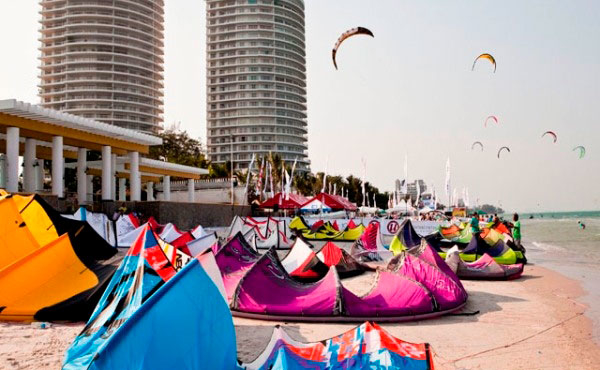

Phuket
Phuket is located in the south west of Thailand at the Andaman Sea and is the biggest island in Thailand. It is a well known tourist destination famous for its luxury resorts and nightlife.
There are 2 kite-spots in Phuket. One is in Nai yang which is a small cosy area in the north, a 5 minute drive from the airport. The best time to kite here is from May through October. It’s a small bay with a shallow area for beginners and an area with some waves for more experienced riders. The wind can be on and off at this location, and is often followed by rain. May and September are usually the wettest months.
The other main spot is on Rawai beach in Chalong bay, on the south-east coast of the island. The best time to kitesurf here is from November through March. It has flat and choppy water with thermal winds, which are best in the mornings. Both locations have a few schools offering lessons and equipment rental.
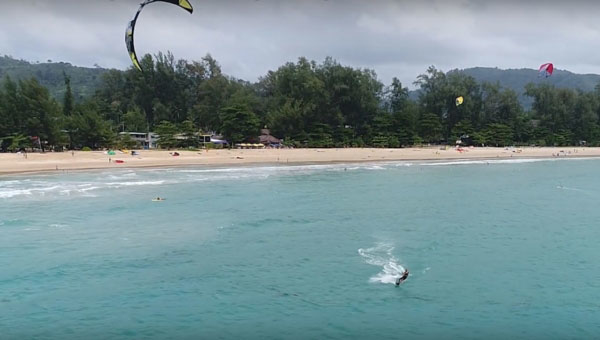

Koh Samui
Koh Samui is the second largest island in the gulf of Thailand and is famous for its white sandy beaches, coconut groves, rain forest, luxury resorts and spas. There are a few areas which are good for kitesurfing.
One is located a few 100 meters south from Nathon pier on the west coast of the island. This location is good from July until October when the winds come from the west. This time of the year the weather can be unpredictable with some big cloud formations bringing strong winds up to 30 knots, as well as some light wind days. Sometimes the winds come before strong rainfalls. The spot is a shallow bay with waist high water protected by a reef.
Another spot that is good when the wind comes from the west is Bangrak beach or better known as Big Buddha beach. The water here is flat and has deep and undeep areas also depending on the tides.
During the high season, between December and April, when the winds comes from the east, there are 2 locations suitable for kiteboarding. One is in Maenam in the North of the island. The other one is at Ban Harn beach on the South-East coast of the island. The east winds are much more stable and are usually not accompanied by rainfall.
You can find a kiteschool on everyone of these spots that offers lessons and equipment rental.


Chumphon
Chumphon province is located in the top of Southern Thailand and is one of the least famous kitespots in Thailand. The main kitespot is located on Thung Wua Laen beach or also called Cabana beach. This place is off the beaten path of mainstream tourism and is very quiet, so if you’re looking for peace and quiet, you’ll find it here. The main season goes from mid October through mid January and brings good north east winds.
Cabana beach is 3 km long and sandy which offers enough space to setup and launch a kite. During high tide the beach can be a bit narrow. The wind is side-on shore, which is ideal for learning how to kiteboard, and usually blows best in the afternoon. The wind passes by a big mountain that’s upwind of Cabana beach which causes another acceleration and pushes the wind to a few knots more. The water can be a bit choppy with bigger waves now and again but there is a big sandbank which creates a waist deep flat water area, ideal for beginners. There are 2 kite-schools here which provide lessons and equipment rental. A bonus for kitesurfers is that there are no jetskis or motorboats allowed on the water.
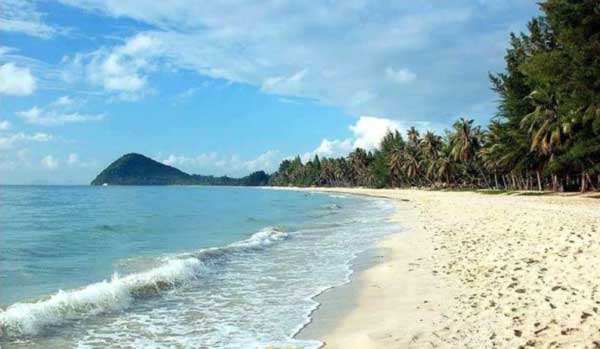
Rayong
Rayong is a city on the East coast of the Gulf of Thailand two hour drive from Bangkok. Best time to kite in Rayong is between mid November and mid January when the wind is coming from the North-east. The wind can be a bit gusty and is at it strongest in the late morning around 10-11 oclock. Late afternoon the wind gets less strong. During this season the best spot to ride is at Rock garden beach resort entry point. The beach is quite wide in low tide with clear water and sandy bottom. The water gets slowly gradually deeper and is ideal for students to learn. It also has nice long small waves.
The second season runs from June until September. This is the south west monsoon season. The winds are on and off with the incoming of clouds and rain. The best month for kiteboarding is August. During this time the best spot for learning is called Laem Son. It has shallow water for at least 1 km. The water is also very clear and with sandy bottom. This spot is good if the wind is coming from the South East or South West because of the shape of the bay.
The options for finding a kiteschool are limited and mostly catered towards Thai people. There is also not a big online presence. If you happen to visit Rayong go to Haad Suan Son beach where you can find a kiteboarding school which is also the location for the famous freestyle, race and hydrofoil competition. Rayong has a few of it’s own local competitions like the ‘Rayong Kiteboarding Championships’.


Pattaya
Pattaya is a famous tourist destination 100km from Bangkok on the eastern gulf coast of Thailand. It is known for its fancy resorts, shopping malls and nightlife. There are tons of activities catered to tourists. One of them is kitesurfing.
All kitesurfing schools are located on Jomtien beach 10km south from Pattaya city. There are 3 schools operating in this area and there is even one specifically for hydrofoiling. From mid November until mid January the wind blows from the north-east with speeds between 12 and 25 knots. The wind is side to side-off shore and the tides are high during this time of the year. Luckily for us they made Jomtien beach motorsport free which means no loud engines of any kind. Only wind powered activities are aloud here.
From mid January up until June the wind comes the west. The winds are lighter but onshore and in combination with the lower tides (waist deep) this time of the year it is easier for beginners to learn. The rain season starts in May and lasts until November. During this time the winds are pretty light.
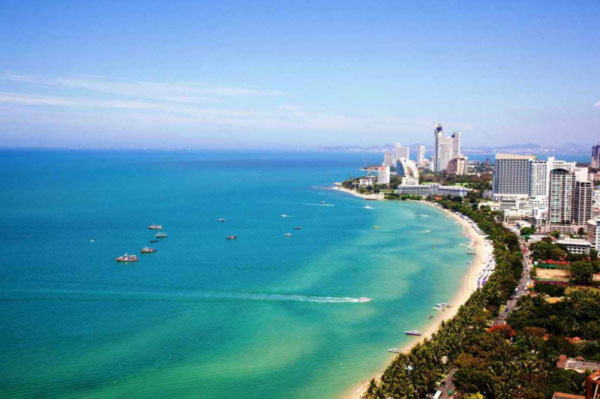
Pak Nam Pran
Pak Nam Pran is located in the Pranburi district and is half hour drive from Hua Hin. It’s mostly occupied by some small fishing communities and a few luxury resorts. It’s home to one of the biggest and most beautiful national parks in the country, Khao Sam Roi Yot National Park. It has a 10km long sandy beach which is luckily not over run by tourists.
The first season starts in November and ends in January. This time of the year the wind comes from the North East and can be quite strong. Expect some waves when the wind is boosting. The wind is usually best in the mornings and starts to decrease mid afternoon.
The second season goes from February until June. During this time the winds come from the South and are a bit less strong but more consistent and stable. Since there is a thermal effect the winds are better in the afternoon starting around 12-1 pm. There are also some shallow flat spots to practice for beginners.
Pak Nam Pran has 2 professional kiteschools and is famous for it’s long down winders and a few international kiteboarding competitions.
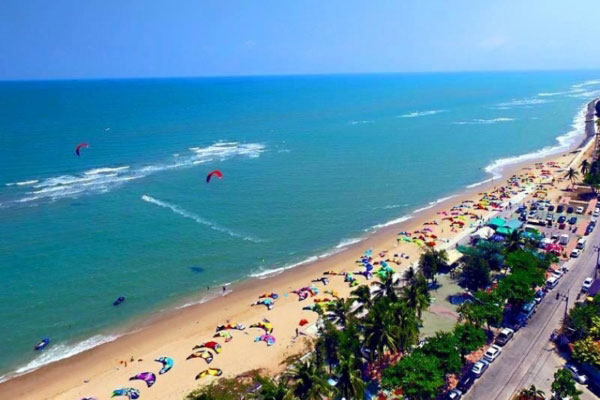

SECTION 2: CHOOSING A SCHOOL
Locations
When you want to learn kiteboarding in Thailand it’s important to know which location is suitable during which time of the year. Schools in Thailand typically have their own kite spots on the beach, and may share other spots when the wind shifts. The main thing to be mindful of when choosing a school is the wind during your stay, as depending on the prevailing wind of the season, some spots will have wind and others will not. The last thing you want to do is get settled for a week of planned lessons and discover there’s an offshore wind, with the only available spot an hour’s drive away.
Use this guide to have an idea in which area of Thailand you will find the most chance of wind at that time and check online for the current wind forecast. Try Windguru, Windfinder or Windy.
The winds can be unpredictable, so it’s recommended that you email a few of the kite schools and ask them about the conditions directly.
Schools & Instructors
If you are going to learn how to kitesurf in Thailand it’s important to choose a school that has instructors that are certified, experienced and that you can understand what your instructor is telling you. In Thailand, instructors come from all over the world, so English skills will vary. Have a conversation with your instructor before starting to make sure you can understand them clearly.
Most if not all kite schools are on Tripadvisor and you can also see reviews on their Facebook pages or google business profiles. If you are already in the area, just drop by the school/spot and have a quick chat with the owner(s), and feel the vibe for yourself.
Some schools work with radio helmets which can be very useful once you are making your first rides since the instructor can give you direct instructions and feedback while you are riding. KITEFLIP is the only school in Thailand that uses the latest bluetooth radio helmet technology witch built in speakers and 2 way communication. This way the student can talk back to the instructor which makes a big difference. The helmets are comfortable and the sound quality is great. Check out the video below!

It turns out Barack Obama learned how to kitesurf using the same Bluetooth radio helmets. He practiced for two days with Richard Branson on Necker island and managed to ride already more than a 100 meters. You can read the full store HERE.
What kind of lessons to choose from?
Discovery course
This is usually a one day course (2-3 hours) in which you will learn the basics of kitesurfing. The lesson will start with some theory about the wind, the spot and equipment. After you learn to set up the kite and connect the lines and bar. This usually takes around 45 min. The rest of the time you will spend on the water learning how to fly the kite. ‘Kitecontrol’ will be the biggest part of this course.
Complete Beginner Course
This is the course you need to take when you want to become an independent kiteboarder. This course takes usually around 9hrs, spread over 3 days. Here you will learn all the theoretical and practical know-how to kite in a safe way. The Discovery course is actually the first day of the complete beginner course. In day 2 and 3 you will learn how create power with the kite and ‘bodydrag’ through the water. This means making strong moves with the kite which will make the kite pull you through the water. You will also learn things like how to relaunch the kite from the water after it falls down and launching it from the beach when you want to start. The main part of the lesson will be how to ride the board. This is where it all comes together.
Customized Course
This is a course for someone who already has some experience with kitesurfing and is looking to improve their skills. This is usually a private 2 or 3 hour lesson in which the instructor specifically focuses on the skill set of the customer. Examples of specific goals that a student could have are: improving their kitecontrol, riding upwind (against the wind), learning to how make a transition (change direction) etc..

After the lesson you should always get an IKO card on which your instructor will note the level you have reached. The levels range from knowing theory about the wind up until riding upwind and jumping. When you didn’t have the chance to finish the complete course in one school you can continue with another school somewhere else in the world. Your IKO card will show which level you reached so they know where to pick it up. After each lesson you should get another IKO card with the updated level.
Your IKO certification is recognized in most schools worldwide. The International Kiteboarding Organisation has set the safety standards for teaching kitesurfing all over the world and continues to strive towards a safe and success full teaching system.
In general most students will be riding the board on their own after the full beginner course of 9 hours. Some people will pick it up more quickly; others might need a bit more time. It’s important to stay patient and don’t give up! If you feel you are out of energy please inform your instructor to take a break or continue the next day.
What to bring / not to bring
Like in any sport, preparation is everything. That said, when you’re learning to kitesurf in Thailand, your kiteschool will provide almost everything you need. What you have to bring yourself is some swimwear. For guys we recommend boardshorts and a lycra shirt. For girls we recommend bikini shorts and also a lycra. Speedos and small bikini’s are less common. Depending on which time of the year and in which area of Thailand you will take a lesson, it is wise to always ask your kiteschool if it will be necessary to wear a wetsuit. It could get cold out there, even in Thailand.
Sunglasses are essential in Thailand, but be sure to wear them on a strap since they are easy to lose. Be sure they are properly UV protected. If they are cheap and you are not sure it is better to not wear them at all. When we learn how to control the kite, we spend a lot of time looking up towards the sun. Because sunglasses make our pupils dilate, there is a higher chance your eyes get damaged from the sun if there is no UV filter.
It’s wise to apply a strong sunscreen before going to your lesson, preferably twice, and in particular on your face. You’ll be looking up toward the sun for most of your lesson. You also get the glare off the surface of the water, so it’s pretty easy to toast yourself beyond well done out there.
It’s also a good idea to wear a hat, but like your sunglasses, you’ll want to fix it to yourself using an elastic string. There are many local shops in Thailand that sell these cheap hats that are very useful for this case and protect also your neck from the sun
One simple rule: Don’t wear anything that can not get wet or can’t withstand salt water!!
SECTION 3: HOW IT WORKS / KITE THEORY
Kitesurfing is a sport that like many other sports needs practical experience to master it. This said, it’s good to know already some theory before you would start with your lesson to have an idea how things work. We will go explain here most of the Theory that you will learn from your instructor before you actually fly the kite on the water.
The Wind
In kitesurfing the wind is always in your back. It’s impossible to kite facing the wind. When you feel the wind in your back, everything that is direction in front of you we call down-wind. The direction that is facing behind you is called up-wind. You can compare it with a river. You can follow the river downstream (downwind) of go against the water upstream (up-wind). These two terms are used a lot in kitesurfing.
At your kitespot it’s important to know the direction of the wind. For beginners, we only kite when the wind is onshore, side-onshore or side-shore. This means the wind is blowing to the beach. If something goes wrong, the wind will always push you and the kite back to the beach. As well, wind that comes over the water is usually much more stable than wind that comes over the land.
It is very dangerous to kite in off-shore wind because it could blow you into the open sea. In some spots like a lake or lagoon it’s possible to kite in off-shore winds, but you should always make sure there is a rescue boat on stand-by. In Thailand you will always learn in onshore, side-onshore or side-shore winds.
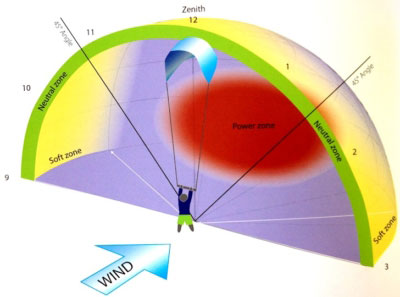
When you are learning how to kitesurf in Thailand your instructor will also talk about the ‘wind window‘. This is actually the area where your kite can fly. It’s a 3 dimensional area that looks like a quarter of a bowl. If you look at the picture you will see that the edge of the wind window resembles the upper half of a clock with 12 o’clock straight above the kiteboarder. This is the zenith or safe spot! We use this to indicate where the kite is positioned. For example the kite is at 10 o’clock or at 2 o’clock. The lines from the bar are around 20 – 24 meters long. When the kite is on this edge of the wind window there is not much power and the kite doesn’t pull us much. But as soon we make a strong move with the bar the kite will move into the front of the wind window and that’s where the power zone is. Always make sure your wind window is completely empty, meaning no other kiters, swimmers, object, etc..
The Kitespot
It’s important to know the kitespot where you will be kiting. Every spot is different and has their own unique features and dangers. Some have high waves with a strong current. Others are flat with a reef that protects it from the open sea. In general look out for other kiters, swimmers, boats, anything on the water basically. Some spots have corals or rocks so you need to wear booties. Your instructor will explain the specific things to look out for at your kitespot.
Kite Equipment
There are basically 3 things you need to be able to kitesurf. A kite+bar, board and harness. There are many different types and sizes of kite. Your school should use a kite that is suitable for beginners and the correct size for your body weight and wind strength. This means the bigger the kite the more power it has, so when the wind is strong you need a smaller kite than when the wind is light. Also someone who is heavier needs a bigger kite then someone who is lighter. It’s important your kite is in good condition and reliable. Most schools will use a freeride kite that is easy to relaunch from the water.
As for the harness there are two different types of harnesses; a seat harness and a waist harness. The difference between them is that a seat harness has leg straps that prevent the harness from riding up to your chest. Although these can be sometimes uncomfortable around the groin area, they are recommended for students. When your skills improve, most people switch to a waist harness. Every harness should have a safety leash and linecutter connected to it.
There are many different sizes and shapes of boards. In Thailand most kiteschools use big boards (light wind boards) for beginners, especially when the wind is not so strong. This makes it easier for the student to find their balance and ride upwind. After your skills improve, you will likely switch to a smaller, more agile board.
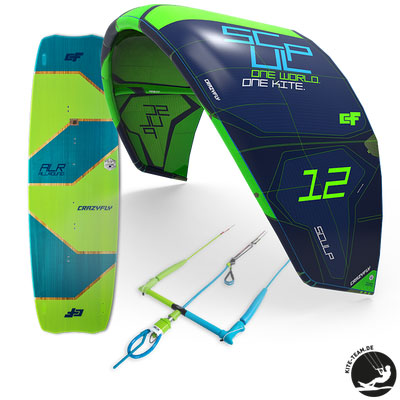
Setting up your kite
After the theory it’s time to set up the kite. First you’ll learn how to pump the kite properly. This means knowing how to inflate it and the appropriate pressure. You will also learn how to move the kite over the beach and how to put it down in the correct way so it doesn’t blow away.
Next, you’ll connect the lines to the bar. The lines need to be separated before connecting them to the kite, and none of them should be tangled. Once that is done, your instructor will show you how to connect the bar to your harness and how the safety systems work on the bar. These are very important and need to be practised well before going out on the water.
At this point, you’re ready to launch the kite from the beach into the air! The safest way to do this is to have one person (student) holding the kite vertically while the other person (instructor) takes the bar and stands in a 90 degree angle with the wind. Once he is in the good position the instructor will give the thumbs up signal and steer the kite up in the air.
Kitecontrol
From this point on you are on the water learning how to steer the kite left and right, how to keep in kite in one position, one hand control, walking with the kite, relaunching the kite from the water, making powermoves, bodydragging, waterstart, boardriding, transitions, self-rescue, etc…
These are all things you can only learn by practicing it, so it’s time take that first step, CONTACT A PROFESSIONAL KITESCHOOL HERE and learn in a safe way! Good Luck 😉
About The Author

Written by Philip Simons. I Arrived 6 years ago in Thailand and am still enjoying it every single day. I started out in Hua Hin and Phuket but fell in love with the magical island of Koh Phangan, followed my dream and opened a kiteschool here. After answering the same questions for years about when and where to kitesurf in Thailand, i decided to make this complete guide to answer all your questions. My goal is to share my passion for kitesurfing and let people feel how much fun this sport can be, especially in a tropical place like this.





